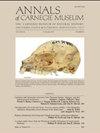澳大利亚、马来西亚和巴布亚新几内亚蚤类(管翅目)记录及Bibikovana Traub一新种记述(蚤科)
IF 0.9
4区 地球科学
Q4 PALEONTOLOGY
引用次数: 1
摘要
罗伯特·特劳布的跳蚤收藏品保存在卡内基自然历史博物馆。从20世纪60年代开始,在收集跳蚤的高峰期,从澳大利亚、马来西亚和新几内亚收集了许多标本,并提供给Robert Traub。大量的出版物由此产生;然而,特劳布博士在完成大部分工作之前就去世了。在他死后,可获得的标本从未被充分研究过,而且在许多情况下,没有得到充分的管理(酒精材料、身份不明的载玻片、小瓶干燥的标本等)。在对14个属(作者分六部分发表)进行深入审查之后,从卡内基博物馆获得了更多的标本。新增标本为首次报道的蚤科9科32种。本研究中包括的许多标本是Hastriter(2012)和Hastriter在2013年至2021年间出版的六部分系列(part I-VI)中相关的补充标本(但未报道)。在这些材料中,有一种新的Bibikovana Traub, 1980年,来自澳大利亚,Bibikovana acumena,与Bibikovana colossus关系密切(Rothschild, 1906)。对这一新分类单元进行了描述和图解。五种跳蚤的分布范围被扩展:1)Porribius caminae (Rothschild, 1903年)扩展到塔斯马尼亚,2)Neopsylla dispar Jordan, 1932年扩展到婆罗洲岛(马来西亚沙巴州),3)Bibikovana engilisi Hastriter, 2021年扩展到巴布亚新几内亚,4)Pygiopsylla zethi (Rothschild, 1904年)扩展到塔斯马尼亚的Mole Creek和Bridport, 5) Smitella thambetosa Traub, 1968年扩展到巴布亚新几内亚。八项新的主持人记录包括:1) Smit弓形虫,1953,on Rattus giluwensis Hill, 1960, 2) Stephanocircus pectinpes Rothschild, 1915, on Pseudomys novaehollandiae (Waterhouse, 1843), 3) Stephanocircus simsoni Rothschild, 1905, on Pseudomys higginsi Trouessart, 1897, 4) Bibikovana engilisi Hastriter, 2021, on microperorcyctes papuensis (Laurie, 1952), 5)荷兰寄生物,1969,on米帕普ensis, 6) glomerospinosus Hastriter, 2016, on Cercartetus caudatus (Milne-Edwards, 1877),7)荷兰直趾虫traubi, 1969年,在Mi. papuensis的巢中;8)Smitella thambetosa Traub, 1968年,在Mammelomys rattoides上(Thomas, 1922)。宿主数据支持了chistopsylla ochi (Rothschild, 1904)的主要宿主,并确定为Trichosurus vulpecula (Kerr, 1792)。讨论了每个物种的宿主关联,并提供了宿主和各自跳蚤物种的列表。本文章由计算机程序翻译,如有差异,请以英文原文为准。
Records of Fleas (Siphonaptera) from Australia, Malaysia, and Papua New Guinea with the Description of a New Species of Bibikovana Traub, 1980 (Pygiopsyllidae)
ABSTRACT The Robert Traub collection of fleas is maintained in the Carnegie Museum of Natural History. During the height of collecting fleas from the 1960s onward, many specimens were collected from Australia, Malaysia, and New Guinea and provided to Robert Traub. A plethora of publications resulted; however, Dr. Traub died before he could finish much of that work. Following his death, specimens were available that had never been fully studied, and in many cases, inadequately curated (alcohol material, unidentified slides, vials of dried up specimens, etc.). Following the in-depth reviews of 14 genera (published in six parts by the author), additional specimens were obtained from the Carnegie Museum. These additional specimens represented 32 species in nine flea families and are reported here for the first time. Many of the specimens included in this study, are supplementary specimens associated (but not reported) by Hastriter (2012) and in Hastriter's six-part series (Parts I–VI) published between 2013 and 2021. Among the material was a new species of Bibikovana Traub, 1980, from Australia, Bibikovana acumena, that is closely related to Bibikovana colossus (Rothschild, 1906). This new taxon is described and illustrated. The ranges of five flea species are extended: 1) Porribius caminae (Rothschild, 1903) to Tasmania, 2) Neopsylla dispar Jordan, 1932, to the island of Borneo (State of Sabah, Malaysia), 3) Bibikovana engilisi Hastriter, 2021, to Papua New Guinea, 4) Pygiopsylla zethi (Rothschild, 1904) to Mole Creek and Bridport, Tasmania, and 5) Smitella thambetosa Traub, 1968, to Papua New Guinea. Eight new host records include: 1) Sigmactenus toxopeusi Smit, 1953, on Rattus giluwensis Hill, 1960, 2) Stephanocircus pectinipes Rothschild, 1915, on Pseudomys novaehollandiae (Waterhouse, 1843), 3) Stephanocircus simsoni Rothschild, 1905, on Pseudomys higginsi Trouessart, 1897, 4) Bibikovana engilisi Hastriter, 2021 on Microperoryctes papuensis (Laurie, 1952), 5) Parastivalius gressitti Holland, 1969 on Mi. papuensis, 6) Rectidigitus glomerospinosus Hastriter, 2016 on Cercartetus caudatus (Milne-Edwards, 1877), 7) Rectidigitus traubi Holland, 1969, in a Mi. papuensis nest, and 8) Smitella thambetosa Traub, 1968 on Mammelomys rattoides (Thomas, 1922). Host data supporting the primary host of Choristopsylla ochi (Rothschild, 1904) was presented and determined to be Trichosurus vulpecula (Kerr, 1792). Host associations are discussed for each species and a list of hosts and respective flea species are provided.
求助全文
通过发布文献求助,成功后即可免费获取论文全文。
去求助
来源期刊

Annals of Carnegie Museum
综合性期刊-动物学
CiteScore
2.50
自引率
18.20%
发文量
4
审稿时长
>12 weeks
期刊介绍:
Annals of Carnegie Museum is a quarterly journal that publishes peer-reviewed short and medium-length original scientific contributions in organismal biology, earth sciences, and anthropology, in 40 by 52.5 pica format (168 by 220 mm or 6-5/8 by 8-5/8 inches). Subject matter must be relevant to Carnegie Museum of Natural History scientific sections or Powdermill Nature Reserve (PNR), preferably with connection to the Carnegie collection and/or personnel. Carnegie Museum staff and research associates receive publication priority, but others are encouraged to submit papers, especially those manuscripts explicitly based on the Carnegie collection.
 求助内容:
求助内容: 应助结果提醒方式:
应助结果提醒方式:


